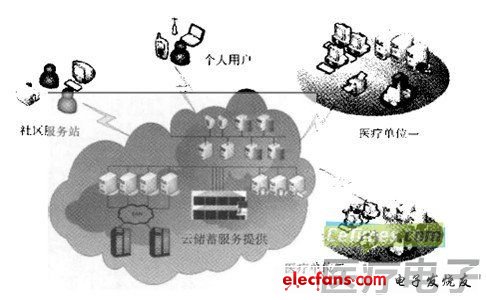Cloud computing is a translation of English Cloud CompuTIng, and Chinese appeared only in early 2008. It was Dell that first proposed Cloud CompuTIng from the enterprise level, but it was the IBM-Google parallel computing project and Amazon EC2 products that had a profound impact on the concept of cloud computing. Later, more and more media, companies, and technical personnel began to chase cloud computing. Even many IT innovations are put into the cloud computing concept, so that the cloud computing concept and industry can be promoted and developed, forming a complete including today IaaS, PaaS, XaaS, and many hardware manufacturers, infrastructure operators, etc. Industry chain.
1. The concept, characteristics and application of cloud computing
1. What is cloud computing
At present, there is no uniform definition of the concept of cloud computing in the world, but in general we can be divided into two categories of concepts: one is narrow; the other is broad.
(1) Cloud computing in a narrow sense
The network that provides resources is called the "cloud". The resources in the "cloud" seem to users to be infinitely expandable, and can be obtained at any time, used on demand, expanded at any time, and paid for per use. This feature is often referred to as using IT infrastructure like hydropower.
(2) Generalized cloud computing
This kind of resource pool is called "cloud". "Cloud" is some virtual computing resources that can be self-maintained and managed, usually some large server clusters, including computing servers, storage servers, broadband resources and so on. Cloud computing centralizes all computing resources and is automatically managed by software without human involvement. This frees application providers from worrying about tedious details and can focus more on their business, which is beneficial to innovation and cost reduction. To draw an analogy: This is like changing from the ancient single generator model to the centralized power supply model of the power plant. It means that computing power can also be circulated as a commodity, just like gas, water and electricity, it is easy to access and cheap. The biggest difference is that it is transmitted via the Internet.
In general, cloud computing is the development of parallel computing, distributed computing and grid computing, or the commercial realization of these computer science concepts. It is the result of a mixed evolution of concepts such as virtualization, utility computing, infrastructure as a service, platform as a service, and software as a service.
2. The principles of cloud computing
Cloud computing is the development of distributed processing (Distributed CompuTIng), parallel processing (Parallel CompuTIng) and grid computing (Grid Computing). It provides Internet users with services (computing, computing, Services such as storage, software and hardware), which effectively improves the efficiency of the use of software and hardware resources, enabling users to enjoy the convenience of high-performance parallel computing through cloud computing.
3. The main features of cloud computing
The US National Institute of Standards and Technology summarizes five basic characteristics of cloud computing: First, on-demand self-service. Consumers can unilaterally deploy computing resources (such as server time and network storage) to automatically meet demand without the need for manual cooperation from service providers. The second is the ubiquitous network connection. Cloud computing resources can be obtained through the network and accessed through standard mechanisms that can facilitate users to use cloud computing through heterogeneous thin client platforms or thick client platforms (mobile phones, laptops, handheld computers, etc.) . The third is a resource pool that has nothing to do with geographic location: the cloud computing service provider adopts a multi-user mode, and dynamically allocates and reallocates physical resources and virtual resources according to user needs. Users usually do not need to know the specific location of these resources. Resources include memory, processor, memory, network, virtual machine, etc. Fourth, deploy resources quickly and flexibly: Cloud computing vendors can quickly and flexibly deploy cloud computing resources, quickly zoom in and out. For users, cloud computing resources usually appear to be unlimited, and any number of resources can be purchased at any time. Fifth, service billing: By billing different types of services, the cloud computing system can automatically control and optimize resource utilization. It can monitor and control resource utilization and generate reports to provide transparency for cloud computing providers and users on the services used.
Combining the meaning of the above cloud computing, some characteristics of cloud computing are obtained.
(1) Large scale. The scale of cloud computing is huge. Google cloud computing already has more than 1 million servers, which also makes the Google search engine occupy the first place in the world.
(2) Virtuality. Through cloud computing, users can use a laptop or a mobile phone and other terminals to obtain application services through network services at any location without worrying about the specific location where the application is running.
(3) High reliability. Cloud computing provides a strict permission management strategy, which reduces the troubles of data loss and virus intrusion in the traditional way, and the reliability of data storage is high.
(4) Strong scalability. In order to meet the needs of application and user scale growth, the scale of "cloud" can be dynamically expanded.
4. Cloud computing applications
For general users, the most commonly used application areas of cloud computing are email, web search (Google or Baidu), photo sharing (Flickr), video sharing (Youtube, Tudou), network map (Google Map), etc. As long as a browser such as a computer or mobile phone has a browser, you can quickly get information from a remote computer in a few seconds, making information readily available, like electricity and running water.
In addition, for software designers and scientists, cloud computing also provides powerful computing capabilities, which can simulate experiments such as nuclear bomb explosions and DNA structures. What are the business opportunities for cloud computing? According to data from the International Data Information Center (IDC), the average annual growth rate of cloud services in the next five years is expected to reach 26%; Merrill Lynch estimates that the global cloud computing market will reach 95 billion US dollars in 2013; market research institutions Cloud computing is ranked as the top ten IT industry trends in the future. According to its report, by 2012, 400 of the Fortune 500 companies will use various cloud computing services.
5. Development status of cloud computing
Because cloud computing is the result of a mixed evolution of multiple technologies, its maturity is relatively high, and it has been promoted by large companies, and its development is extremely rapid. Large companies such as Amazon, Google, IBM, Microsoft, and Yahoo are pioneers in cloud computing. Many successful companies in the field of cloud computing also include Salesforce, Facebook, Youtube, Myspace, etc.
In China, the development of cloud computing is also very rapid. On May 10, 2008, IBM's first cloud computing center in China was established in Wuxi Taihu New City Science and Education Industrial Park. On June 24, 2008, IBM established the second cloud computing center in China—IBM Greater China Cloud Computing Center at the IBM China Innovation Center in Beijing; 21Vianet launched the CloudEx product line, including a complete Internet hosting service, based on Online storage virtualization services, serial cloud computing services such as data preservation services for individuals and businesses to perform internet cloud backups; China Mobile Research Institute started cloud computing earlier, and has completed the cloud computing center test.
There are two main development directions for cloud computing in the future: one is to build a large-scale underlying infrastructure that is tightly integrated with the application, so that the application can be expanded to a large scale; the other is by building a new type of cloud computing application. Provide a richer user experience on the network. The first development trend can be reflected in the current cloud computing research situation, and in the construction of cloud computing applications, many new social service networks, such as facebook, have already reflected this development trend, and in research Then began to focus on how to integrate multiple services through the cloud computing basic platform.
6. Problems with cloud computing
Judging from the current application situation, cloud computing technology has the following shortcomings: (1) Even with the best virtualization technology, users cannot migrate applications to the "cloud"; (2) The migration of enterprise tasks to the cloud environment requires huge Workload; (3) Only the user's consent can realize the virtualization of all IT assets to form an "internal cloud" for seamless operation of "external cloud"; ⑷ has not really provided cloud computing services according to actual needs, and can The actual use of resources pays; ⑸ The management application software provided by the data center is poorly integrated with the company's existing management application software; ⑹ Cloud computing does not have a unified standard to regulate, and it is difficult for enterprises to adopt large-scale.
In addition, experts at the Black Hat Security Conference in August 2009 raised five security flaws regarding cloud computing security issues: (1) Cloud computing does not provide adequate legal protection; (2) Cloud computing does not have ownership of hardware; (3) Cloud computing needs to be powerful The agreement and user training guarantee; ⑷ Do n’t believe the virtual machine instance created by third-party developers; ⑸ In any case, enterprise information technology managers need to reconsider the configuration on the cloud.
Cloud computing is now at an elementary stage, and it also requires people's in-depth understanding, and spend great efforts to properly manage complex resources. Therefore, its popularity will take some time.
2. Development and status of ECG telemonitoring
In modern society, cardiovascular disease is a serious threat to human health and life and is currently the leading cause of death for Chinese people. The prevention and diagnosis of cardiovascular disease is of great significance to the whole society. Due to the accidental and sudden nature of cardiovascular diseases, it is particularly important to monitor ECG patients in daily life.
The ECG remote monitoring system originated from the Holter system. The early family ECG monitoring system used electronic instruments to record and store the patient's daily electrocardiogram and other important physiological parameters, and periodically sent the data to the clinic for diagnosis. The patient can be away from the hospital to monitor at home . Early family ECG monitoring requires analysis of ECG data after the monitoring is over. It is not real-time, and the patient cannot be diagnosed and treated by a doctor in time when the patient becomes ill. And because its storage capacity is too small, only a very small amount of ECG data can be stored, and the integrity of the data cannot be guaranteed. Some valuable ECG data is inevitably lost, which greatly reduces the accuracy of diagnosis.
With the rapid development of modern communication technology and its application in the medical field, in recent years, the ECG remote monitoring system has undergone revolutionary changes, Holter has gradually evolved into the front-end device of the ECG remote monitoring system, the traditional Holter and The combination of computer networks and mobile communication technology is becoming more and more obvious. With the popularization and development of macro-infrastructures such as the Internet (Internet) network and mobile communication networks, ECG monitoring has been developing rapidly along the Internet and wireless mobile monitoring in recent years.
Internet-based remote ECG monitoring system refers to the use of ECG monitoring client to collect patients' ECG signals, and then transmit the ECG signals to the server of the monitoring center through the Internet, waiting for medical staff to process and diagnose the patient's ECG. The whole system is generally composed of three parts: client terminal, Internet and management center workstation. The client terminal is composed of an ECG signal collector and a workstation that can be connected to the Internet. It can complete functions such as collecting patient ECG signals, performing simple data processing, and uploading data to the Internet. According to different ways of accessing the Internet, the system has different design schemes, mainly including PSTN (Published Switched Telephone Network, public switched telephone network), ISDN, Ethernet and so on. The workstations of the remote ECG monitoring management center are generally equipped with high-performance servers, which can receive patient ECG data in real time, store and analyze data, manage patient basic data and ECG data, and network security management.
The ECG wireless monitoring system based on the mobile communication network adopts a portable ECG signal monitor and uses wireless communication technology to carry out data communication with the monitoring center. Wireless transmission does not require cable media, and users can be monitored by the monitoring center anytime, anywhere, regardless of time and location. With the increasingly perfect communication technology and computer network technology, the research hotspot of ECG telemonitoring in recent years is to closely combine wireless communication technology and Internet technology. The combination of the two technologies makes up for the deficiencies of restricting the subject to a fixed environment when relying solely on the Internet; it also makes up for the fact that when relying solely on wireless technology, the data of the subject can only be transferred between mobile monitoring terminals , Resulting in high costs, not easy to popularize, single data processing and analysis methods and other deficiencies.
The wireless, networked and humanized ECG monitoring system is the development trend. Portable, modular, easy to operate and low-cost ECG monitoring products will become the mainstream in the future market. The third-generation mobile communication 3G technology that is gradually being developed can greatly increase system capacity, improve communication quality and data transmission rate, and utilize seamless roaming technology between different networks to better connect the wireless communication system to the Internet So as to provide a more stable and stronger technical foundation for the ECG remote monitoring system. The ECG telemonitoring system integrates the development achievements of biomedical engineering, information technology and communication technology, and can make full use of the resource advantages of the mobile communication network and the Internet. An increasingly important role.
3. The application of cloud computing in medical informatization and ECG remote monitoring
The cloud computing that emerged in the past two years is to centralize all computing resources and realize automatic management by software without human participation. It means that computing power can also be circulated as a commodity, which is as convenient as gas and water and electricity, and cheap. Therefore, healthcare companies can carry out informatization construction by purchasing computing power without having to build related facilities. This allows enterprises to focus more on their business without worrying about tedious details. The emergence of cloud computing technology will bring a whole new understanding to medical information construction. Through the cloud computing platform, hospitals can “outsource†websites, e-mail systems, information management systems, remote monitoring systems, and data centers and security systems to cloud computing service providers, no longer have to worry about how to build and maintain server environments , How to purchase and upgrade system software, application software and anti-virus software, how to prevent hacker intrusion. Whether it is data services or application computing, everything is obtained directly from the network. This is like using water and electricity. End users only need to turn on the switch or faucet to get and enjoy the service. Power plants and water plants with huge resources are responsible for providing the most professional production and maintenance on the other end of the "cloud". . Figure 1 shows the cloud storage service model in medical informatization.

Figure 1. Cloud storage service model in medical informatization

Based on the idea of ​​using "cloud computing" to realize remote monitoring of physiological parameters, we designed a multi-parameter remote monitoring system based on B / S architecture, whose structure is shown in Figure 2. The whole system consists of the central monitoring server software (cloud) of the monitoring center, client browser and multi-parameter collector. The server-side software (cloud) can accept data transmission requests from two clients, and realize remote real-time monitoring of multiple patient physiological parameters based on the Internet. The client uses B / S architecture, without installing any client program, as long as you open the browser, you can view and send physiological parameters and waveforms in real time (see Figure 3). The remote central monitoring system based on B / S architecture facilitates the deployment and maintenance of client software, extends the central monitoring system from the hospital ward to the community or family, and provides new solutions for the popularization and networking of medical instruments.

Figure 3 Client monitoring interface
In the new wave of medical reform, medical service informatization will be an inevitable trend. Through information technology, the establishment of resource sharing between medical and health institutions can achieve optimal integration of medical service resources and maximum synergy. It will be very impressive. Cloud computing concepts and technologies that use computing resources as services will surely change the development concept and construction model of traditional medical informatization, and play a vital role in advancing the construction of medical informatization.
Yaxing`s high performance films are resistant to extreme temperature, chemicals&moisture. It was widely used in Chemical storage bags and Chemical resistant liners.
With our specialized equipment and processes we can provide tight tolerances and fast setup services to meet your needs.
Characteristics:
·Excellent chemical stability
·Extremely low friction coefficient
·Good abrasion resistance
·Outstanding Moisture resistant
·Perfect anti-corrosion resistance



Release Film,Bonding Film,Ptfe Membrane,Non Stick Film
TAIZHOU YAXING PLASTIC INDUSTRY CO., LTD , https://www.yaxingptfe.com